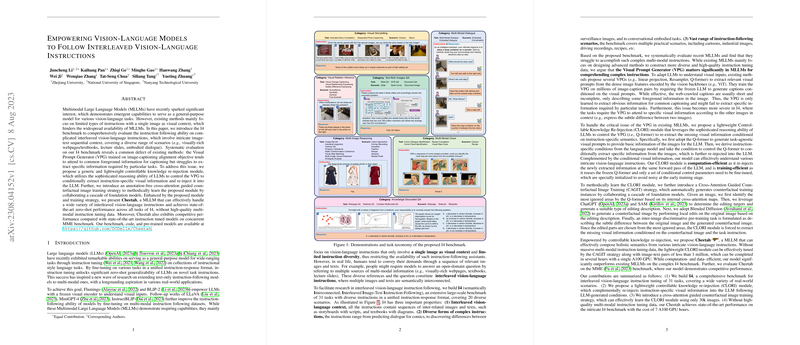Overview of "Fine-tuning Multimodal LLMs to Follow Zero-shot Demonstrative Instructions"
The paper "Fine-tuning Multimodal LLMs to Follow Zero-shot Demonstrative Instructions" addresses the challenge of improving Multimodal LLMs (MLLMs) for better understanding of complex multimodal instructions. Traditional MLLMs, which utilize Visual Prompt Generators (VPGs) trained on image-caption pairs, often miss crucial visual details necessary for comprehensive instruction comprehension. This work introduces the Visual Prompt Generator Complete (VPG-C) module to address these omissions and enhance MLLM performance.
Key Contributions
- Introduction of VPG-C:
- VPG-C is a novel and lightweight module that can infer and complete missing details essential for comprehensive comprehension of demonstrative instructions. It integrates seamlessly with existing MLLMs, addressing the limitations of current VPGs that focus only on primary visual contents.
- Synthetic Discriminative Training Strategy:
- The paper proposes a synthetic discriminative training strategy to fine-tune VPG-C. This approach does not require expensive supervised demonstrative instruction data and introduces synthetic training tasks to diagnose and remedy the overlooked details by VPGs.
- DEMON Benchmark Creation:
- The authors introduce DEMON, a comprehensive benchmark designed to evaluate MLLM performance on demonstrative instruction tasks across various categories. This inclusion allows for systematic evaluation of models on interleaved visual-textual contexts.
Significant Results
- Performance Improvements:
- VPG-C demonstrates a substantial improvement in zero-shot performance across all tasks on the DEMON benchmark. The effectiveness is further validated by evaluations on the MME and OwlEval benchmarks, with notable enhancements in visual reasoning and language generation tasks.
Implications
- Theoretical Implications:
- This research underlines the importance of addressing inductive biases in MLLMs, suggesting that models can be significantly improved by integrating modules like VPG-C that effectively capture and utilize residual visual information.
- Practical Implications:
- VPG-C enhances the utility of MLLMs in practical settings such as multimedia content analysis, interactive AI applications, and complex decision-making tasks, where understanding detailed multimodal instructions is crucial.
Future Directions
- Scalability:
- Adapting VPG-C for larger and more diverse datasets to further validate its scalability and robustness.
- Integration with Emerging Models:
- Exploring the integration of VPG-C with other emerging architectures and paradigms in AI to broaden its applicability.
- Advanced Synthetic Training Techniques:
- Developing more sophisticated synthetic training methods that leverage advanced text-to-image diffusion models to create richer discriminative tasks.
The paper provides a promising direction for enhancing multimodal LLMs' capabilities beyond standard image-caption generation, marking a step forward in comprehensive multimodal reasoning and instruction following.
